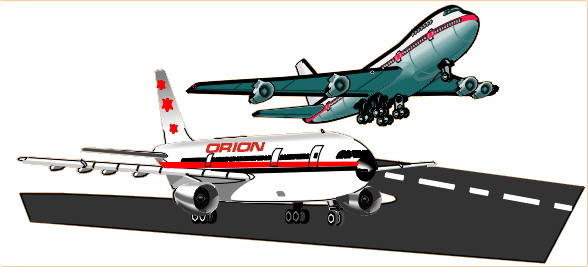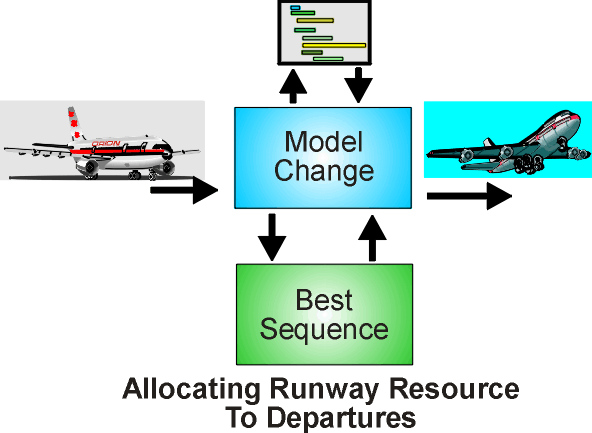

Orion Active Structure technology has been used to develop a Ground Movements scheduler for a large airport. A Requirements Elicitation phase led to the model construction phase. The knowledge modelling technology relies on the initially undirected interaction of elements in a network, so the problems of specifying and building a complex program are avoided because the network is capable of both phasing and altering itself.
The components which make up the model are those used in financial analysis, strategic planning and project management, so it is easy to extend the model in many ways that would be closed to a special purpose scheduling algorithm. The same model structure that is appropriate for dynamic scheduling can be used to study the viability, responsiveness and cost-effectiveness of the application.
Airports are busy places, with many aircraft queuing to take off. There are constraints acting between different sorts of aircraft, light aircraft must wait until the wake vortices from large aircraft have subsided, a faster aircraft must be delayed if it follows a slower one on the same heading. There is relatively short notice between when a aircraft becomes available to pull back from the gate, to when it takes off. Choosing the most efficient sequence, and then resequencing without obvious churning if a new aircraft would drop into a slot, is a demanding task. The investment in the airport is so great that small increases in capacity from better sequencing can show good returns. Mechanisation of the sequencing requires a system that can respond rapidly to input information, have new constraints imposed easily by the Ground Controllers, and roll through the day, acting on the aircraft it sees, having some depart and some arrive, the structure of its constraint network being updated every minute or so.
The usual programming approach has difficulties with this sort of dynamic environment, as new constraints can appear more quickly than a programmer can go back and reprogram an algorithm which was done by someone else, or whose workings have been forgotten.
Attempting to capture knowledge in rules also leads to problems, because it is not clear whether A influences B, or vice versa. The undirected structure avoids the limitations imposed by directed rules.
Knowledge modelling allows complex changes to be made by merely describing the new constraints, the alteration to the topology of the network structure causing the desired change in behaviour.
Modelling the knowledge about the application directly leads to the construction of a "sequencing machine". The model is split into two functional elements -
A model change element which accepts a new aircraft, adding the appropriate constraints to the other aircraft in the model, and removes a aircraft that has taken off, and whose constraints are no longer active.
A sequencing element which determines the best sequence for the aircraft currently in the model, taking into account the time they have waited, the likelihood of more aircraft coming, and so on.

There is no complex algorithm to build, because the scheduling method is largely non-algorithmic - the interaction of the elements of the model leads to the solution of the sequencing problem. Add new elements and the behaviour changes, because the behaviour comes from the interaction of the elements. The use of heuristics is minimised, with each decision obeying all the constraints imposed on the operation of the takeoff runway.